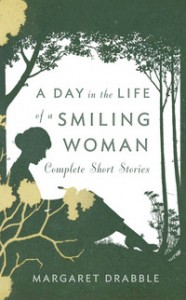July 2, 2011
A Day in the Life of a Smiling Woman by Margaret Drabble
 All right, please forgive me, but I’d like to take the short story off its pedestal for just a moment or two. Not to demean it in any way, but rather to point out the utter banality of proclaiming a writer “a master of the short-story form”. If only because I don’t think there is any such thing as “the short story form”, which is of all forms is probably the most elastic. Think about what Ann Beattie has in common with Alice Munro, I guess. Or closer to home, even Sarah Selecky and Jessica Westhead’s stories are altogether different creatures. There is such diversity in short stories, which is the underlying flaw in any argument against them as a form, but it also means that many of us are sputtering critical banality when we try to talk about them in general.
All right, please forgive me, but I’d like to take the short story off its pedestal for just a moment or two. Not to demean it in any way, but rather to point out the utter banality of proclaiming a writer “a master of the short-story form”. If only because I don’t think there is any such thing as “the short story form”, which is of all forms is probably the most elastic. Think about what Ann Beattie has in common with Alice Munro, I guess. Or closer to home, even Sarah Selecky and Jessica Westhead’s stories are altogether different creatures. There is such diversity in short stories, which is the underlying flaw in any argument against them as a form, but it also means that many of us are sputtering critical banality when we try to talk about them in general.
But then, here is another thing…
Margaret Drabble’s complete short stories A Day in the Life of a Smiling Woman were written by a writer who has never been called a master of the short story form, mostly because most people don’t know she ever wrote short stories, because she only wrote a handful of them, and because she had been altogether occupied attempting to become master of the novel instead. (And can I just say that more than most contemporary novelists, she has probably come very close?)
But yet there are stories here which are masterful, because this is Margaret Drabble after all and she is so, so good. So the conclusion I take from this is that the short story form isn’t necessarily one requiring fervent devotion, the way some would like us to think it is– I’m referring to the pedastal. The conclusion is that anyone is capable of writing an excellent short story… as long as anyone happens to be Margaret Drabble.
The stories here, which are organized in chronological order, represent the same kind of trajectory evident in the progression of Drabble’s novels. Early stories are very focussed on the individual, interior and immediate, and were very fashionable in a way that hasn’t aged terribly well (but their quality remains evident). Her middle stories become more political with a strong feminist bent, and then the later ones are concerned with the limits of fiction, with stretching these limits, and also with history, and science and questioning. A reader seeking something conventional from later-Drabble will come away disappointed, but with an understanding of what she is trying (though not always managing) to achieve), the reader can appreciate these works’ greatness.
It is difficult to talk about a collection like this, which represents the work of five decades and was never intended to be discussed as a whole. Except to say that it’s a wonderful overview of (and perhaps introduction to?) Margaret Drabble’s work, and a must-read for any of her devotees. That a few of the early stories have a certain unsteadiness, but then the other assume the assurance of writers who, if she has not necessarily mastered the short-story form, has certainly managed to master the story in general.





